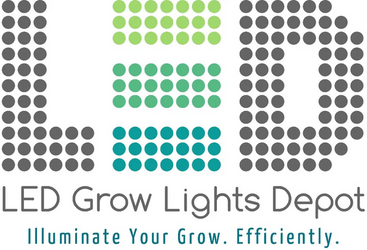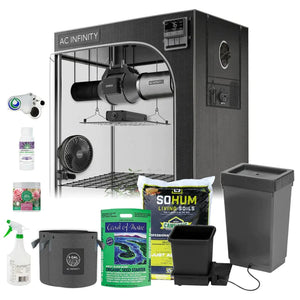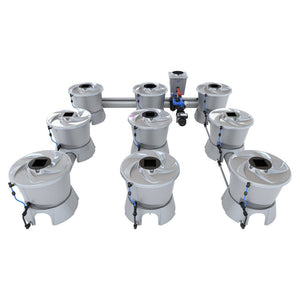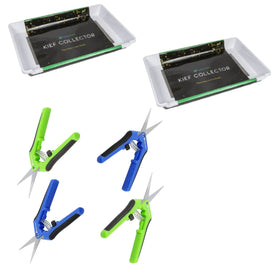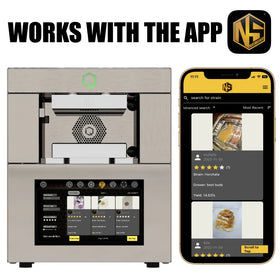
HLG Tomahawk 650 LED Bar Light Review

In this post, I'll be reviewing the new Tomahawk 650 bar light by Horticulture Lighting Group (HLG)! From the company that patented Quantum Boards, this is HLG’s first bar light.
HLG also makes a Tomahawk 720. I won't be covering this fixture in this review, but just know that the Tomahawk 720 has exactly the same build the Tomahawk 650 and uses a more powerful driver. It draws about 10% more power, puts out 10% more heat, and 6% more light.
Now, let's dig into the Tomahawk 650.
Build
This fixture comes folded in half in a discreet brown box. Also included is a Mean Well power supply, RJ box with a dimmer, 120V to 240V adapter, wire hangers, ratchet hangers and some hardware for securing the fixture and power supply. Before you hang up the light, you will need to unfold the fixture and secure it from closing up on itself with two screws. If attaching the power supply to the fixture, you can do that at this time using the 4 longer screws. Otherwise, you can mount the power supply remotely with the optional driver extension cable.

The fixture frame is quite light. HLG built this as minimal as possible. It seems as if they used as much aluminum as necessary to hold the fixture together, provide stability, and properly heat sink the diodes. I know the fine folks over at HLG would not build a fixture that did not have enough aluminum to properly draw the heat out of diodes, so with some tests, they must have settled on this amount of aluminum backing the diodes.
The heatsinks contain reflectors, which HLG has started adding to all of their medium-sized to larger-sized fixtures. These help direct about 10% more light down toward the canopy opposed to the non-reflector design.
The RJ control box can be mounted anywhere within the cords reach. You can connect a 0-10V controller to this control box, or instead choose to use the manual dimmer.

Diodes
The Tomahawk 650 contains full spectrum cool white diodes and 660nm deep red diodes. There are not any UV or far red diodes in this fixture. I was asked by HLG to not to say much more about the diodes since these are a new horticulture diode from a well established company and I don't think HLG wants to give away any secrets here. I was also told that Steve, one of the owners of HLG, helped develop this diode in partnership with that well-known company. Pretty cool!

Sometimes grower’s get wary when they don't know the exact diode model in the fixture. However, this should not be a primary focus. What is more important is the PPF (light output) and PPE (PAR efficacy) of the fixture as a whole, not just what the specs say on the diode data sheet. The light output and PAR efficacy of the entire system is what matters. The entire system being the diodes, driver, and all.
Take AC Infinity's new IONFRAME series as an example. They are using the new Samsung LM301H EVO diode in the series, but this is not the ONLY diode that they are using. So, when you add those other diodes in there, the fixture is probably producing less light and is less efficient than if only the EVO diodes were used.

Plus, AC Infinity does not even state the total light output or PAR efficacy of the fixtures so how does the light perform as a whole? This is one reason why we can’t only consider the diode specifications and need the proper data from an integrating sphere that measures total light output and PAR efficacy of the fixture.
Specs
That being said, what is the light output and PAR efficacy of the Tomahawk 650? The fixture produces 1859 PPF at 2.8 PPE, which is pretty darn good! It’s not HLGs best performing light, but it’s up there!
HLG states that this light draws 650W. Which is pretty close to what I got when I tested it with a Kill-O-Watt meter.
The coverage area of this fixture is a strong 4'x4' or up to a 5'x5' depending on how much light you would like to bathe your plants in. Say, if you are used to putting about 1700 PPF in a 4'x4' area, you will want about 2600 PPF for a 5'x5' to get the same amount of light per square foot. Therefore, you can see how this light trends towards more of a 4'x4' coverage area at only 1859 PPF. But, the beginner to average home grower would still be able to use this light in a 5'x5' tent to grow some nice plants.
PAR
HLG has two PAR maps for the Tomahawk 720 - one at 12” and one at 18”. We can adjust these values down by about 6% to get the PPFD readings for the 650W since there is about a 6% difference in light output between the two lights. 6% is pretty small, so the readings that you see on these PAR maps for the 720 are just a bit higher than what the 650 would come in at.
PAR taken at 18" in a 5'x'5 open area

PAR taken at 18" in a 5'x'5 open area

These readings appear to not have been tested in a tent based on the lower PPFD readings at the edges and corners, so take that into consideration when judging these PAR maps. Many growers using an LED grow light will be using it in a tent or in an application where there are several lights in a single area and this would reduce hotspots and increase uniformity.
Summary
So, does this light live up to its expectations? Yes, it certainly delivers. Top of the line components, meets minimalist design, meets HLG. A recipe for a great light! It’s design is quite novel…or different… which may be a turn off for some growers, but you shouldn’t let aesthetics get in the way of performance. The reflectors are such a great move, and you don't see many companies use a reflector design to increase delivered light to the canopy, except perhaps Mars Hydro on their TS series.

As LED grow lights have evolved, there have been a plethora of copy cat companies building on Fluence's bar light design. So, HLG took their time before entering the bar light market, wanting to make a bar light and entering when it was the right time for them. Some might say a few years TOO late, but Quantum Boards have worked for HLG since the beginning and are still working quite well for growers. Is this bar light a new direction for HLG or just a one off design to say they have a bar light? Only time will tell.
Now, how does this compare to the Scorpion Diablo V2? The Diablo V2 draws about 10% more watts, puts out 10% more light, is about 6% more efficient, but is 30% more expensive. Overall, the Diablo V2 is a better light, but may not be for growers looking to save some money and not deliver TOO much light to their 4'x4' area. But the best bang for your buck between the two lights would be the Tomahawk 650.

The Tomahawk 650 comes in at $899, so it’s a little bit more expensive than many other bar lights on the market. Performance-wise, this light rivals many of the other lights that I have tested in a 4'x4' tent. The amount of light delivered to the canopy is awesome! Plus, when you buy an HLG light you are buying an excellent 5-year warranty. If anything happens to the light, HLG has some of the best customer service in the industry, so that peace of mind is worth the extra cost, in my opinion. If this light is within your budget, I would say go for it. You won't be losing anything and only gaining extra light delivered to your canopy.
Use code hlg10off for 10% off this light or any other HLG item at ledgrowlightsdepot.com. Shop the Tomahawk 650 here.
